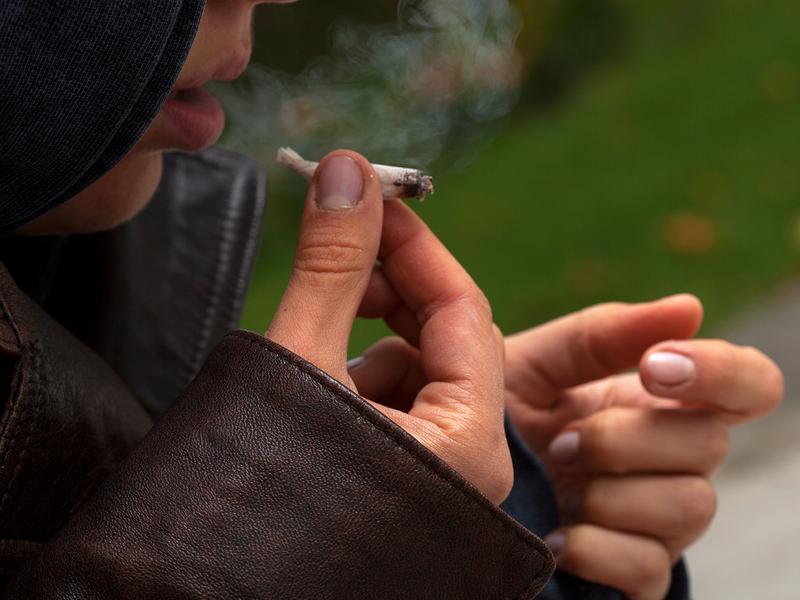Study Erred In Finding No Link Between Teen Pot Use And Psychosis

Updated Jan. 22. 3:49 pm ET: The American Psychological Association emailed us to say that the correction they issued on Thursday was incorrect. The email says in part:
I am afraid that the correction we put out regarding the teen marijuana study was not accurate. We are in the process of placing this more accurate editor's note on the release on our website.
The original correction issued on Thursday by the APA said:
The study, published online Aug. 3 in Psychology of Addictive Behaviors, has been corrected because of a statistical error that affected some of the findings.
An excerpt from the updated correction posted on the APA website now reads:
Although these supplemental analyses indicated that teens who engaged in frequent marijuana use had a higher probability of meeting criteria for a psychotic disorder than infrequent/nonusers by their 30s, this difference did not reach statistical significance using a two-tailed test (p=.09).
We contacted the lead author of the study, Jordan Bechtold at the University of Pittsburgh Medical Center. In response, she writes to Shots in an email:
There were no errors in the original analysis. The analysis in the supplemental paper was slightly different than the original analysis. The goals in producing the commentary were to supplement the original paper with a new set of analyses, and to provide a word of caution regarding the interpretation of the results, particularly the psychosis findings.
The analysis used in the original study is called a two-tailed test. This looks for an effect in two directions. For example, it could test if marijuana increases the risk for psychosis and if marijuana reduces the risk. A one-tailed test would only look at one of those possibilities.
Here's the original post:
A surprising study that found no connection between male teens' marijuana use and the risk of psychotic disorders is in error, the researchers said Wednesday.
When the results were published last August in a journal of the American Psychological Association, even the researchers said their findings were surprising. Over the past couple of decades, there have been at least 10 different epidemiological studies that found smoking marijuana increases risk for developing psychosis later in life.
The APA released a statement saying that the "results from this study generated considerable controversy, including requests for supplemental analyses" because most previous studies have found that chronic teen cannabis users might be more prone to health problems, including mental illnesses and physical illnesses like respiratory problems.
This study, published in Psychology of Addictive Behaviors, originally found no connection between physical and mental problems in adults and smoking marijuana in their teen years.
Most of the studies on mental illness and weed, including this one, don't perfectly tease apart whether young adult cannabis use causes things like bipolar disorder or schizophrenia or if it's the other way around, says Krista Lisdahl, a clinical neuropsychologist at the University of Wisconsin in Milwaukee who was not involved in the study.
As we've written in Shots before, people with emerging psychotic disorders could be more likely to use weed than others. "Still, controlling for risk factors, marijuana does seem to increase the risk for psychotic disorders," Lisdahl says.
Once the researchers reanalyzed their data, they found that the men in the study who smoked weed as youngsters were more likely to have psychotic disorders, but still were not more likely to report any health problems than nonsmokers. The men are in their mid-30s, so it's still possible that an increased risk for problems that are more common in older folks, say heart disease or cancer, could appear in time.
It is curious that the researchers still didn't find a link between depression and weed smoking. This, too, has been connected in previous studies. If people with emerging psychotic disorders are more likely to use weed because they're trying to self-medicate, then you might imagine people with depression might do the same thing.
But Lisdahl says, it's really important to remember this study had about 400 men and no women. "It's really important to not generalize this to female," she says. "In my studies, the female marijuana users are the ones that really show increased depression and anxiety symptoms."
So, there are a few things that this study didn't examine, not to mention the wrong calculation around psychosis. The APA says the error is a statistical one. It could have come from a coding mistake when the authors analyzed the data, or it could be varying results from different statistical methods — the authors couldn't be reached for a comment at this time. In general, these mistakes are rare, but it also doesn't necessarily mean they're terrible researchers.
To the authors' credit, they admitted a few limitations in the original manuscript. The APA press release states:
The sample included young men who were using marijuana in the late 1990s and early 2000s and THC content has risen recently; data were obtained from self-reports; [statistical] power was low.
The APA statement also says:
The group difference on psychotic disorder approached statistical significance and would have been significant if a more liberal test (i.e., one-tailed) was utilized.
So they knew that the results, particularly where psychotic disorders are concerned, were always in question, and explicitly said so. It also reveals another thing about science: Results can change quite a bit depending on what statistical method you use to evaluate a small data set.
9(MDEwODYxNTQyMDEzNjAxODk2Nzc2NzNmYQ001))